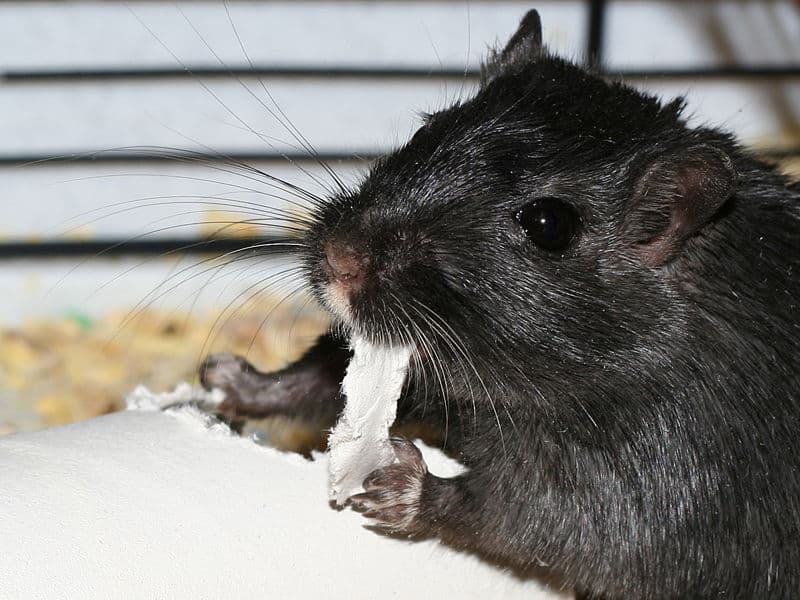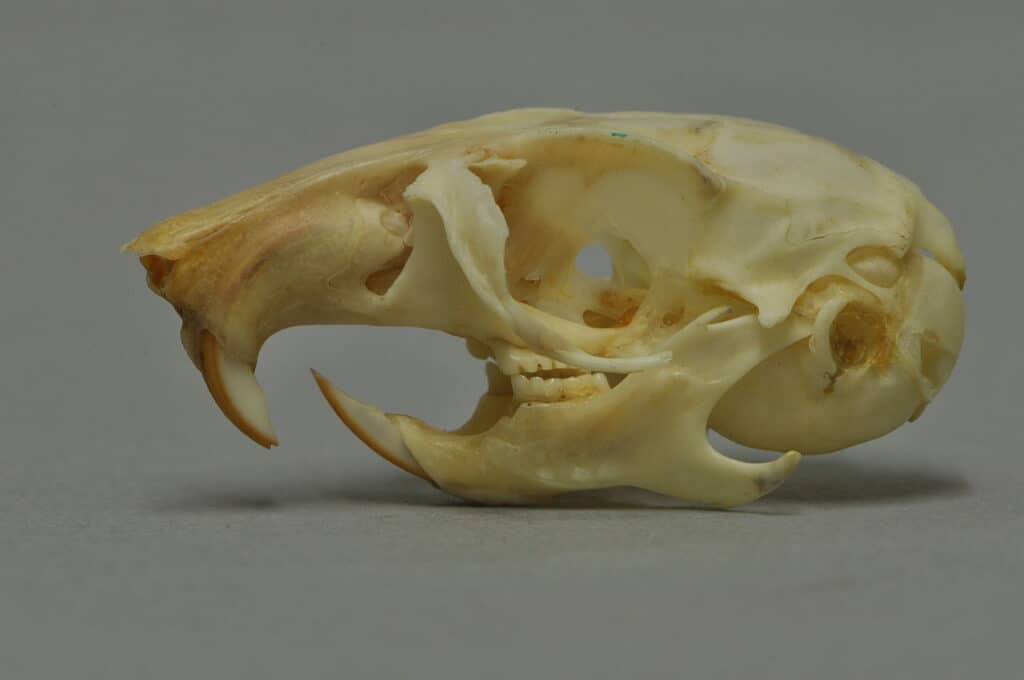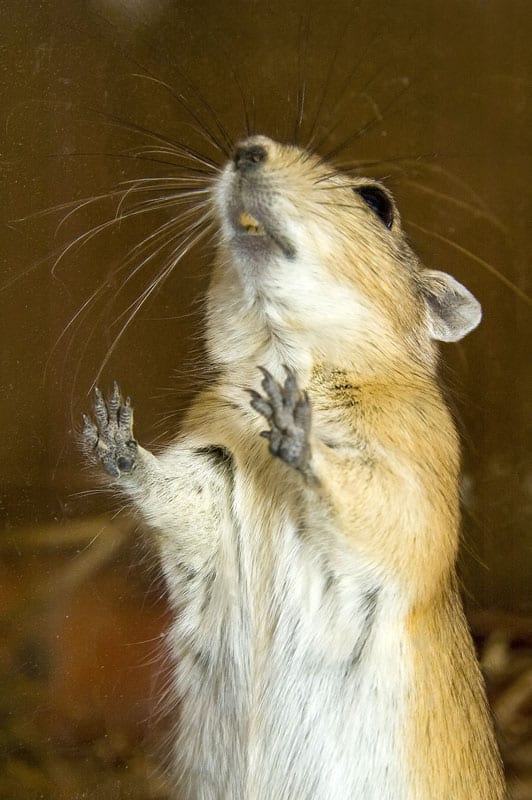If you want a small, low-maintenance pet, you might want to consider a gerbil. Gerbils can grow very attached to their owners, and they are quite interesting to watch. Active and curious, each gerbil has its own distinct personality that you’ll enjoy getting to know.
As far as what they eat, gerbils are omnivores. They enjoy many different foods, including insects, fruits, vegetables, and seeds. They enjoy foraging and chewing, and you can even turn mealtime into a game! Of course, they chew on this food using their teeth. If you want to learn more about gerbil teeth, keep reading!
Are Gerbils Born with Teeth?

Gerbils do not have teeth at birth.
Gerbils are not born with teeth. The pups are toothless and hairless, and their eyes are closed at the very beginning. However, once they open their eyes, between 17 and 19 days old, their teeth have developed.
Gerbil teeth grow very quickly. They are fully developed before the gerbil is three weeks old. At this point, the gerbil pups become very curious about their surroundings and will chew on anything they can find.
By the time the gerbil is five weeks old, they are able to gnaw on adult gerbil food. This is generally about the time they are weaned as well.
Adult Gerbil Teeth

An adult gerbil has 16 teeth.
©Klaus Rassinger und Gerhard Cammerer, Museum Wiesbaden / CC BY-SA 3.0 – License
Just like other rodents, including rats, mice, and hamsters, a gerbil has 16 teeth in total. These include incisors and molars. Gerbils do not have canines; these are the long, pointed teeth that many other animals, including humans, often have at the front corners of their jaws.
In place of each of the canines, a gerbil has a diastema. This is a space that separates different types of teeth from one another.
Gerbil teeth are monophyodont teeth. This means there are no baby teeth that end up falling out. The first teeth a gerbil grows will be its teeth for the rest of its life.
Incisors
Gerbils have four incisors, located at the front of their mouths. These are the most visible teeth when their mouths are open. There are two on the top and two on the bottom. These teeth are very hard and sharp, allowing them to bite their food effectively.
The incisors are the most important gerbil teeth. These are the teeth the gerbil needs to crack open his favorite foods, such as seeds and grains. When the gerbil continuously uses these teeth, they will wear down in length. However, this is fine, because they continuously grow throughout the lifetime of the gerbil.
The lower incisors are longer than the upper ones. However, the difference is so small that you likely won’t be able to see it. The difference is more significant in other rodents.
In order to keep these teeth at an appropriate length, gerbils need to constantly be grinding their teeth.
Molars
A gerbil has 12 molars. There are six on each side of his mouth, with three on the top part and three on the bottom part. These are not as visible as the incisors. The only way you will see them is if you pry your gerbil’s mouth open, which you should not do because this will be stressful for the animal.
Gerbil molars are large, but they are also short and somewhat flat on top. They are fairly comparable to the molars of other animals.
The gerbil uses its molars to break down foods more before it finally swallows them. This is an important part of the digestive process, considering that gerbils eat a lot of fibrous foods.
Unlike the incisors, gerbil molars are not continuously growing. Once they break, they are broken for good. However, this is not as bad as the breakage of an incisor, as these teeth are not as important to a gerbil.
Gerbil Dental Care

Gerbils have to chew regularly.
©iStock.com/IMNATURE
Gerbils’ teeth are constantly growing. If they grow too long, this can be painful for the gerbil and cause health problems. It may even cause him to stop eating.
It’s important to give gerbils objects to chew on regularly. This will keep their teeth from growing too long. These can be wooden blocks; willow, beech, hazel, birch, and fruit tree branches are good for this purpose. Do not give them holly, yew, or ivy branches – these are poisonous and will be harmful to the animal.
You should check your gerbil’s teeth on a regular basis. If they’re overgrown or if you see that one tooth is significantly shorter than the rest, take your gerbil to the vet.
How to Check Gerbil Teeth
If you want to effectively check your gerbil’s incisors, it’s best to do so when your gerbil is munching on something. This way, you can see him using his front four teeth. In order to do this, follow these steps:
- Remove your gerbil from his enclosure. Scoop him up with both your hands, supporting his body while doing so.
- Put one hand under the gerbil’s body, and the other on top. Your hands should be firmly enclosing his body without hurting him.
- Turn the gerbil onto his back, so that you can see his teeth.
- Check the front teeth of the gerbil.
There are a couple of things you want to look for while checking your gerbil’s teeth. First, look at their shape. Make sure they are properly aligned and growing in the correct directions. The top incisors should each be ⅛-inch long, and the bottom ones should be ¼-inch in length. Also, make sure the gerbil is able to eat without problems.
Generally, if there is a problem with only one tooth, your gerbil should still be able to eat. However, it’s a good idea to take him to the vet anyway, just in case. You want to make sure there are no long-term negative health consequences.
You can’t really see your gerbil’s molars without prying his mouth open, and you shouldn’t do this. He’s not going to like this, and he won’t trust you after you do this. In some cases, your gerbil may need to have his teeth trimmed, but you should not attempt to do this on your own unless you have expertise in this area. Your vet can do it for you.
The photo featured at the top of this post is © iStock.com/Devonyu
Thank you for reading! Have some feedback for us? Contact the AZ Animals editorial team.






